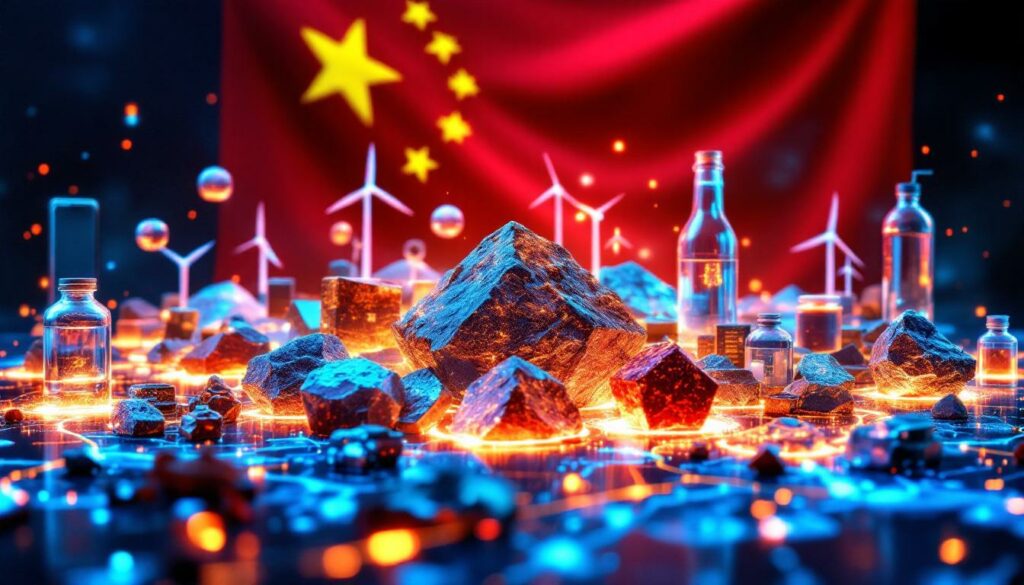China's Rare Earth Smuggling Allegations Spark International Tension
In a move that has sent ripples through global commodity markets, China's Ministry of State Security (MSS) has publicly accused foreign intelligence agencies of orchestrating a sophisticated campaign to smuggle rare earth materials out of the country. These allegations, made via WeChat on July 19, 2025, come amid escalating US–China trade tensions and highlight the strategic importance of these critical minerals in global geopolitics.
What Are China's Recent Accusations About Rare Earth Smuggling?
China's spy agency claims that foreign intelligence services are collaborating with domestic actors to systematically steal and smuggle rare earth elements—crucial components in everything from smartphones to military hardware. According to the MSS statement, these operations pose "serious dangers to national security" and involve complex concealment methods designed to circumvent export controls.
"Foreign espionage and intelligence agencies… collude with unlawful people to steal rare earth items by mail delivery, posing serious dangers to national security," the MSS declared in their public statement, highlighting the severity with which China views this alleged threat.
Sophisticated Smuggling Tactics Identified
Chinese authorities have outlined several smuggling techniques allegedly employed by these foreign actors:
- Mislabeling parcels as "not originally made in China" to avoid scrutiny
- Concealing rare earth powders within ceramic tile ingredients to disguise their true nature
- Hiding materials in water bottles deceptively labeled as "machinery parts"
- Exploiting customs declaration loopholes by using false commodity codes
These methods reportedly exploit vulnerabilities in export control systems, with smugglers taking advantage of the difficulty in visually identifying rare earth compounds without specialized equipment.
The MSS claims to have intercepted multiple shipment attempts, including a significant operation allegedly designed to help an unnamed foreign country stockpile strategic rare earth reserves. The smuggling networks purportedly operate through complex supply chains that cross multiple international borders to obscure their origins.
How Do Rare Earths Factor Into Global Trade Tensions?
The timing of China's accusations is particularly significant given the strategic importance of rare earth elements in global supply chains and ongoing trade disputes between major economies.
China's Dominant Market Position
China's leverage in the rare earth market is substantial and well-documented:
- Controls approximately 70% of global rare earth production
- Produces 90% of the world's rare earth magnets (U.S. Geological Survey, 2024)
- Possesses the most developed processing infrastructure globally
- Maintains the ability to disrupt global supply chains through export controls
This market dominance gives China significant influence in trade negotiations. As noted by trade analyst Alicia García-Herrero, "Rare earths are China's most effective non-tariff trade weapon" (Atlantic Council, 2023).
Impact on Global Manufacturers
The consequences of China's export restrictions have already materialized for major international companies:
- Ford Motor Co. confirmed production cuts at specific facilities due to magnet shortages
- European automotive manufacturers faced component shortages after China restricted neodymium exports in Q1 2025
- Consumer electronics companies have reported supply chain disruptions affecting production schedules
- Defense contractors are reassessing supply chain vulnerabilities for critical components
These disruptions underscore the vulnerability of global manufacturing to rare earth supply constraints. The unique properties of rare earth magnets—particularly neodymium-iron-boron (NdFeB) magnets—make them essentially irreplaceable in high-performance motors, giving China substantial leverage over industries ranging from electric vehicles to wind turbines.
What Recent Developments Have Occurred In US-China Rare Earth Negotiations?
Despite the smuggling allegations, there are signs of potential diplomatic progress in managing rare earth trade tensions between major powers.
Diplomatic Breakthroughs
A tentative agreement reached in June 2025 between the United States and China included several key provisions:
- The U.S. agreed to suspend escalating tariffs on Chinese goods
- China committed to process export licenses for rare earth materials
- The U.S. lifted certain restrictions on AI chip exports as a reciprocal gesture
- Both sides indicated willingness to engage in high-level discussions on critical mineral supply chains
This agreement represents a potential easing of tensions that had been building throughout early 2025. However, analysts note that implementation details remain unclear, and the smuggling accusations could complicate future negotiations.
China's Domestic Rare Earth Policies
In a move that received little public attention, China quietly issued its 2025 rare earth production quotas. According to Bloomberg, this "quota opacity signals China's intent to retain strategic ambiguity" (July 19, 2025) in its rare earth policies.
Other domestic policy developments include:
- Enhanced security measures around rare earth mining operations
- Increased penalties for unauthorized mining and export
- Consolidation of the domestic rare earth industry under state-aligned enterprises
- Technology investment in more efficient extraction and processing methods
These domestic policies reflect China's continued commitment to maintaining control over its rare earth resources while potentially allowing for more regulated international trade.
Why Are Rare Earth Elements So Strategically Important?
The strategic significance of rare earth elements extends far beyond their monetary value, touching virtually every advanced industry and defense capability.
Critical Applications Across Industries
Rare earth elements are indispensable in numerous high-tech applications:
- Defense technology: 50% of global defense tech uses rare earth alloys (Pentagon report, 2023)
- Clean energy: Wind turbines require up to 600kg of rare earth materials per megawatt
- Electric vehicles: Each EV motor contains approximately 1kg of neodymium
- Electronics: Smartphones, hard drives, and speakers all depend on rare earth components
- Medical equipment: MRI machines require substantial amounts of rare earth elements
F-35 fighter jets alone require an estimated 400kg of rare earth materials per unit (Lockheed Martin, 2024), highlighting the defense implications of rare earth supply security.
Irreplaceable Properties
Dr. Jane Nakano of the Center for Strategic and International Studies notes that "no scalable substitutes exist for dysprosium in military-grade magnets" (2023). This irreplaceability stems from rare earth elements' unique properties:
- Magnetic strength: Neodymium magnets are the strongest permanent magnets available
- Temperature stability: Dysprosium and terbium allow magnets to function at high temperatures
- Luminescence: Europium and yttrium enable precise color displays
- Catalytic properties: Cerium enhances pollution control systems
The International Energy Agency (IEA) projects neodymium demand to grow by 250% by 2030, driven primarily by electric vehicle production and renewable energy expansion.
How Are Countries Responding To Rare Earth Supply Chain Challenges?
Nations around the world are implementing multi-faceted strategies to reduce their vulnerability to rare earth supply disruptions.
Diversification Initiatives
Countries are pursuing several approaches to rare earth supply diversification:
- Domestic resource development: The U.S. allocated $6 billion for critical mineral projects under the Inflation Reduction Act (DOE, 2025)
- International partnerships: As Kobold Metals' CEO stated, their "Congo partnership aims to bypass geopolitical bottlenecks" (MINING.com, July 18, 2025)
- Recycling technologies: EU initiatives target 20% rare earth recovery from e-waste by 2030 (European Commission, 2024)
- Strategic stockpiling: Japan maintains a national reserve of critical rare earth materials
- Alternative materials research: Funding for rare earth substitutes has increased substantially
Hydrometallurgical recycling technologies now achieve >95% neodymium recovery rates from magnets, though the processes remain energy-intensive and not yet economically competitive with primary production.
Policy and Regulatory Frameworks
Governments are also implementing policy measures to address rare earth vulnerabilities:
- Critical minerals strategy: National roadmaps identifying priority actions and investments
- Expedited permitting: Streamlined regulatory processes for strategic mineral projects
- Trade agreements: Bilateral and multilateral frameworks prioritizing mineral security
- Research funding: Support for innovation in extraction, processing, and recycling
- Public-private partnerships: Collaboration to develop supply chain resilience
These initiatives reflect a growing recognition that rare earth supply security requires coordinated action across government, industry, and research institutions.
What Are The Implications For Global Rare Earth Markets?
The combination of smuggling allegations, export controls, and diversification efforts is reshaping global rare earth markets in profound ways.
Market Volatility and Price Trends
Recent market developments include:
- Price volatility: Neodymium oxide prices fluctuated by 30% in Q2 2025 (Asian Metal Index)
- Supply premiums: Western buyers now pay approximately 15% premiums for non-Chinese rare earth materials (Financial Times, June 2025)
- Investment surge: Exploration funding outside China rose 45% year-over-year (S&P Global, 2025)
- Processing capacity expansion: MP Materials' U.S. magnet plant reduced import dependency by 35% (Q1 2025 report)
This volatility creates both challenges and opportunities for market participants, with significant implications for industries dependent on rare earth supplies.
Emerging Market Trends
Several key trends are reshaping the rare earth market landscape:
- Provenance verification: Blockchain-based systems like MineHub are being deployed to track rare earth materials from mine to market
- Environmental standards: Growing premium for environmentally responsible production
- Vertical integration: Companies seeking to control multiple supply chain stages
- Geographical diversification: Investment flowing to previously marginal deposits
- Technology innovation: New extraction and processing methods reducing costs
These trends suggest a market in transition, moving from Chinese dominance toward a more diversified but potentially higher-cost global supply chain. The ongoing mining industry evolution has led to increased focus on sustainable extraction methods for these critical elements.
How Do Smuggling Allegations Affect International Relations?
The rare earth smuggling accusations add another layer of complexity to already strained international relations, particularly regarding technology and trade.
Diplomatic Fallout
The smuggling allegations have triggered several diplomatic responses:
- Increased inspections: 12% more EU rare earth shipments inspected since accusations (Eurostat, July 2025)
- Official denials: Western governments have rejected involvement in smuggling operations
- Counter-accusations: Claims that China is weaponizing rare earth exports
- Multilateral discussions: Calls for WTO involvement in resolving rare earth trade disputes
A former CIA officer observed that "such claims often precede expanded export controls" (CSIS, 2024), suggesting the accusations could foreshadow further restrictions.
Security Implications
The smuggling allegations have also triggered security responses:
- Enhanced detection: X-ray diffraction scanners now specifically flag "ceramic tile" shipments for rare earth analysis
- Supply chain monitoring: Increased scrutiny of international shipping manifests
- Research collaboration concerns: Growing restrictions on academic and industrial partnerships
- Intelligence coordination: The U.S.-Australia Critical Minerals Pact includes joint smuggling interdiction protocols (May 2025)
These security measures reflect growing concerns about critical mineral supply chains as national security priorities. Furthermore, tariff impact analysis suggests these developments could lead to significant economic consequences for global manufacturing sectors.
FAQ: China's Rare Earth Smuggling Allegations
What specific rare earth materials are most targeted for smuggling?
According to Chinese authorities, the most frequently smuggled materials are neodymium, praseodymium, and dysprosium—elements critical for high-performance magnets. These three elements represent approximately 95% of magnet-related seizures, reflecting their high value and strategic importance.
How has the rare earth market responded to these allegations?
As MINING.com noted, "market responses remain cautious pending evidence" (July 20, 2025). While prices have shown some volatility, major market participants appear to be waiting for more concrete information before making significant strategic shifts. Increased attention to supply chain verification and due diligence is evident across the sector.
What evidence has China presented to support its smuggling claims?
China has provided limited specific evidence in public forums, focusing instead on describing general smuggling methods and calling for vigilance. Mass spectrometry is reportedly being used to identify disguised rare earth compounds in suspicious shipments, but detailed case information remains classified.
How might these allegations affect future trade negotiations?
The smuggling accusations could serve as leverage in ongoing trade discussions, potentially strengthening China's position in demanding concessions on technology transfer or tariff reductions in exchange for reliable rare earth access. The allegations also provide justification for enhanced export controls under national security provisions.
Disclaimer: This article contains analysis of geopolitical tensions and market trends that may evolve rapidly. The information presented reflects current understanding as of publication date and should not be considered as investment advice or definitive predictions of future events.
Are You Prepared for Opportunities in Rare Earth Discoveries?
Stay ahead of global market shifts with Discovery Alert’s real-time notifications on significant ASX mineral discoveries, powered by the proprietary Discovery IQ model. Explore how past major discoveries have yielded impressive returns by visiting Discovery Alert’s dedicated discoveries page, and begin your 30-day free trial for cutting-edge insights today.




